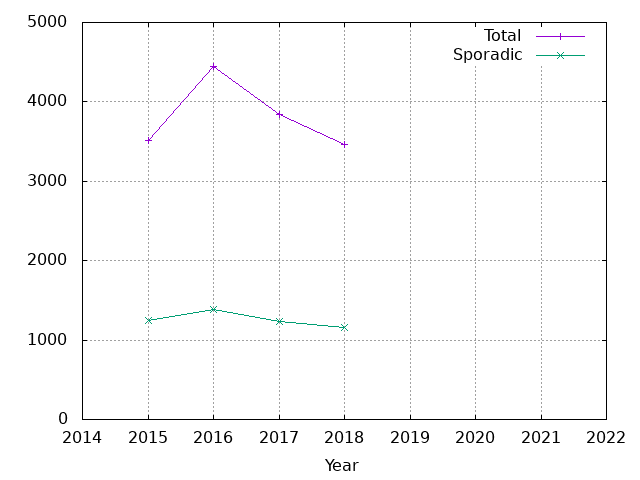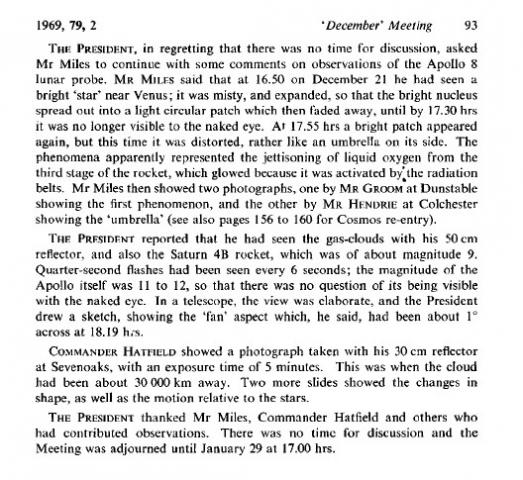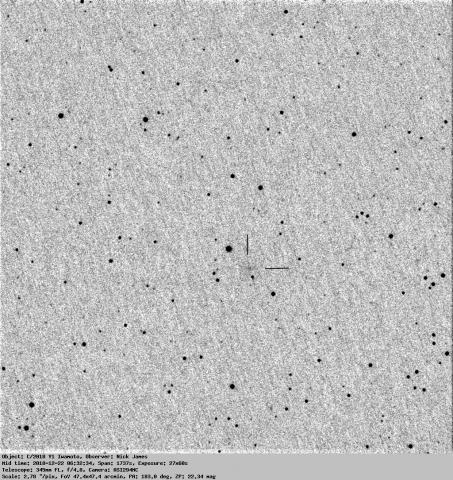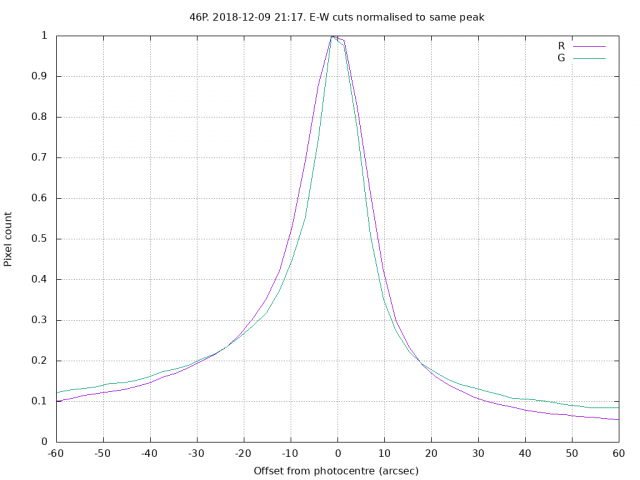Forum Replies Created
-
AuthorPosts
-
 Nick JamesParticipant
Nick JamesParticipantVoyager-1 is currently 3.3 times further away (21.7 billion km vs 6.6 billion km) so the path loss is 10.3dB more. It has an 18W X-band transmitter (NH is 12W) and a larger HGA (3.7 m vs 2.1m). This gives an overall spacecraft EIRP increase of 6.7dB. On the negative side Voyager uses an old FEC code (rate 1/2 concatenated vs rate 1/6 Turbo) which loses around 2.5 dB. Overall the link is around 6 dB worse. I believe that Voyager 1 currently supports TM rates of up to 600 bps to the 70-m DSN stations so this would imply a margin of around 2dB for all losses in that case (it is currently far from solar conjunction).
 Nick JamesParticipant
Nick JamesParticipantBy accident I have just deleted my original comment. so I’ve reconstructed it below. It is a bit techy but basically the data rate back from NH is around 1kbps (equivalent to around 5hrs to transmit a mobile phone picture) achieved using a transmitter with the power of a small LED lightbulb.
The data rate from NH is around 1kbps at the moment achieved using a 12W transmitter and a 2.1m high gain antenna on board the spacecraft. This is received by a 70m DSN antenna on the ground. The link is at X-band and the data is encoded using a rate 1/6 Turbo code. This expands every bit of data into 6 symbols which are then transmitted to the ground. The coding allows the ground to extract good data at a very low signal-to-noise ratio (Eb/No = 0dB). The data is partially phase modulated onto a carrier with some power remaining in the carrier. This provides a discrete frequency tone for synchronisation.
For those that are interested the link budget goes something like:
Spacecraft downlink EIRP +52.8dBW Free space path loss -307.2 dB DSN antenna G/T +61.5dB/K Boltzmann constant +228.6 dBW/K/Hz Bit rate -30dBHz Eb/No 5.7 dB The actual margin is much less than this since NH is currently very near solar conjunction (6 deg today, down to 2 deg on Jan 7) and I haven’t included any factors for transmit and receive losses, modulation loss, pointing losses, weather etc.
A fun fact is that NH is currently around 6.6 billion Km away which is around 160000 times further than a geostationary satellite so the path loss is around 104dB larger than from GEO. That’s a lot.
 Nick JamesParticipant
Nick JamesParticipantHNY everyone!
The closest thing I have to an objective measurement of night-sky conditions in Chelmsford through the year is a plot of the total number of sporadic meteors detected by my two cameras here. This shows much less variation than the total number of meteors since that is biased by the conditions at the time of the major shower peaks. On this criterion 2018 was slightly worse than previous years but the variation is not significant.

 Nick JamesParticipant
Nick JamesParticipantUsing recent astrometry from iTelescope Siding Spring (obtained by myself and Martin Mobberley) the orbit is starting to settle down a bit although it is still very uncertain. The 1 sigma position errors at closest approach in mid February are still around 10 degrees. I don’t think this comet will be particularly bright.
Perihelion 2019 Feb 5.343663 +/- 1.72 TT; Constraint: e=1
Epoch 2018 Dec 23.0 TT = JDT 2458475.5 Earth MOID: 0.2740 Find_Orb
q 1.262 +/- 0.0247 (J2000 ecliptic)
Peri. 357.57 +/- 0.53
Node 146.43 +/- 1.0
e 1.0000 +/- 0 Incl. 160.48 +/- 0.05423 of 25 observations 2018 Dec. 18-23; mean residual 0″.74
 Nick JamesParticipant
Nick JamesParticipantMy main telescope can’t get that low so this was using a portable mount set up at the other end of the garden which has a pretty good southern horizon. This plot shows the brightness of the sky background in the frames of this field. I started imaging just before 05:50 when the comet was about 7 deg aove the horizon and there was some cloud low down. The sky darkened a bit as the comet rose and the cloud cleared and then started to brighten rapidly at 06:30 as dawn arrived. My optimum time was between 06:10 and 06:30 when the sky was at its darkest and the comet was around 10 deg up. Astro twilight started here at 05:57 but my sky low down is so bright from other sources that I didn’t see the effect of the Sun until around 30 mins later. By nautical twilight at 06:39 the sky was brightening rapidly.

 Nick JamesParticipant
Nick JamesParticipantRobin, That’s a wonderful description of a very rare observation made by Chris from somewhere called Chelmsford. This is the JBAA report referenced in the S&T article.

 Nick JamesParticipant
Nick JamesParticipantAt a declination of -24deg and only 10 deg above the horizon at dawn C/2018 Y1 (Iwamoto) is a challenge from the UK. Here’s my image from this morning from Chelmsford. It is currently very slow moving which makes it difficult to get a good orbit. Prospects for it should become clearer over the next few weeks.

 Nick JamesParticipant
Nick JamesParticipantMany congratulations to Masayuki Iwamoto. The comet is currently low in the morning sky on the border of Hydra and Libra slowly moving north and crossing into Virgo in mid-January. As Jonathan says the orbit is currently very uncertain. As soon as we get a bit more astrometry I’ll post some charts here.
As a challenge it may be currently observable from the UK. From Chelmsford it is currrently around 10 degrees elevation in the SSE at the start of nautical twilight (around 0640 UT). This is 10 deg lower and a bit to the right of where Venus is.
 Nick JamesParticipant
Nick JamesParticipantRobin, Yes you’re right about the nucleus diameter (I was thinking it was around the same as Rosetta’s actual target, 67P, but it is quite a bit smaller. Your calculation for the bare nucleus mag is pretty good. JPL Horizons gives a nuclear mag on Dec 9 of 12.85. I get mags of 11.91V, 11.30R in an 11 arcsec diameter aperture and the R profile is definitely broader than G close in (R is mainly dust, G is mainly gas). I think you are seeing the inner dense dust cloud around the nucleus which is probably around 1.5 mags brighter than the nucleus on its own.
This plot was obtained using a widefield system with a pixel size of 2.77 arcsec.

 Nick JamesParticipant
Nick JamesParticipantGreat work from all the spectroscopists on this. The Comet Section Director is obviously going to have to learn a bit more chemistry!
Robin. I think the bare nucleus of 46P is only around 4km in diameter so you won’t be seeing anything from that. Even though most people are imaging the green Swan emission lines from gas in the coma there will be a considerable amount of dust close in. The surface brightness profile of the coma is attached. The dust will be significant in the inner part of the coma.

 Nick JamesParticipant
Nick JamesParticipantI suspect that was what the “:-)” was for!
 Nick JamesParticipant
Nick JamesParticipantYes, the “official” recording won’t be much different to that. We’ll just chop out all of the interval stuff and upload the talks as individual items.
 Nick JamesParticipant
Nick JamesParticipantRobin, That’s a really nice demonstration of the difference betwen the gas and dust in the coma.
 Nick JamesParticipant
Nick JamesParticipantLars. Glad you enjoyed it and found it useful. It’s certainly something that we want to do again when we can.
 Nick JamesParticipant
Nick JamesParticipantHi Ronan. Glad you enjoyed the meeting watching from the west of Ireland. Yes I remember the wonderfully dark skies in Mayo and I hope you’re getting a great view of 46P when the weather cooperates.
 Nick JamesParticipant
Nick JamesParticipantWe’ll certainly try to do this again when we have the opportunity. I’ve just watched a few clips from the meeting on Youtube and the quality is very good. This was a learning experience for us but it worked well and we had around 30 people watching the livestream.
We could livestream this meeting because that the IoP had the facilities and expertise to provide a very good user experience. This is not the case at our other venues. Hopefully we’ll be back at the IoP soon so that we can do this again and, hopefully, some of the other venues we use would be able to offer this in the future.
Thanks again to the IoP for hosting the meeting and to Hazel Collett for the excellent organisation.
Happy Christmas and look out for that comet (and those meteors and variable stars).
Nick.
 Nick JamesParticipant
Nick JamesParticipantThanks for the feedback. It sounds as if it worked pretty well.
 Nick JamesParticipant
Nick JamesParticipantWell, I suppose if we moved it from Winchester to the IoP building in Kings Cross that would work…
 Nick JamesParticipant
Nick JamesParticipantAre you using background from PSF or background from aperture? I think you should always use the latter since the PSF background estimator needs a much biffer photometric aperture to work properly. They often give very different magnitude zero points.
 Nick JamesParticipant
Nick JamesParticipantGeorge. Congrats on another nice discovery. I’m getting 17.4 unfiltered (UCAC-4 R band) tonight (see attached). I think the photometric apertures that you are using in Astrometrica may be a bit small. This may lead to some problems with it estimating the sky background.
-
AuthorPosts
